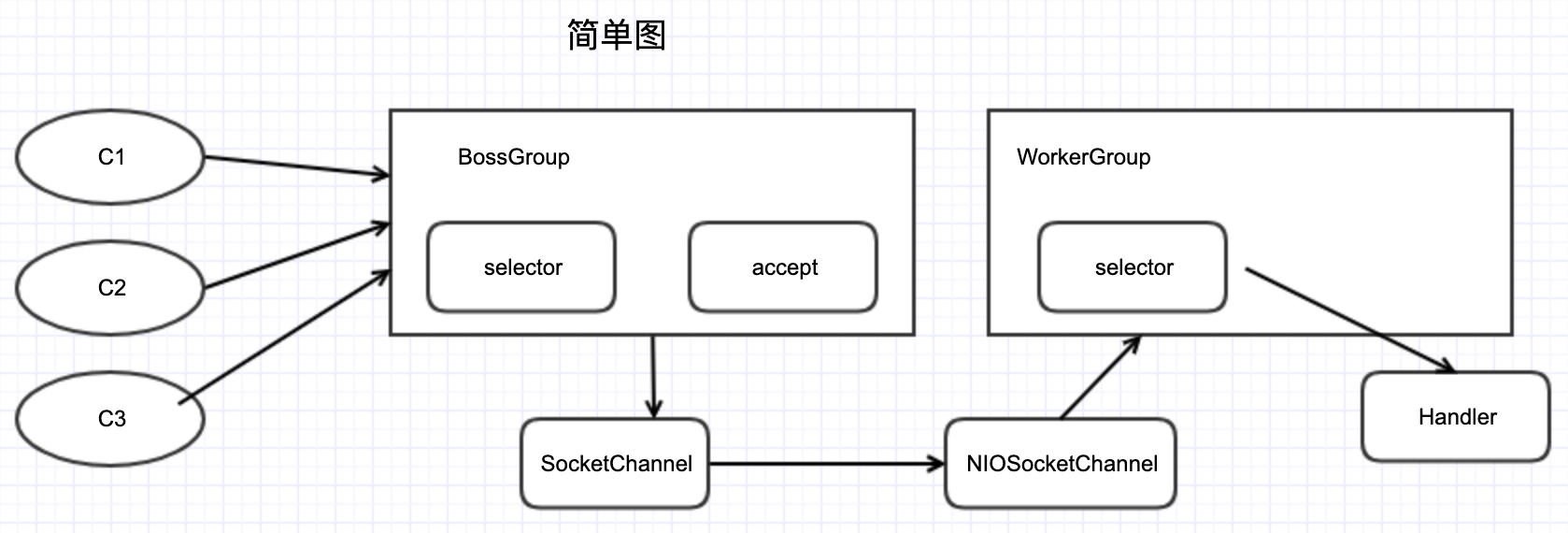005-核心技术-netty线程模型、任务队列、异步模型
一、netty从简到繁解说线程模型
1.1、简单版
 →
→
说明:1)BossGroup线程维护Selector,只关注Accept
2)当接收到Accept事件,获取到对应的SocketChannel,封装成NIOSocketChannel并注册到Worker线程(事件循环)
3)当worker线程监听到selector中通道发生自己感兴趣的事件后,就进行处理(由Handler)注意handler已加入到通道。
1.2、进阶模型
如上图
1.3、详细模型

1)netty抽象出两组线程池:BossGroup负责接口客户端的连接,WorkGroup负责网络读写
2)BossGroup和WorkGroup都时NioEventLoopGroup
3)NioEventLoopGroup相当于一个事件循环组,组中含有多个事件循环,每一个事件都包含NioEventLoop
4)NIOEventLoop表示一个不断循环的执行处理任务的线程,每个NioEventLoop都有一个Selector,用于监听绑定在其上的socket的网络通讯
5)每个Boss NIOEventLoop 循环执行步骤:
a、轮询accept事件
b、处理accept事件,与client建立连接,生成NioSocketChannel,并将其注册到某个Work NioEventLoop上的selector
c、处理任务队列的任务,即runAllTasks
6)每个Work NioEventLoop循环执行的步骤:
a、轮询read、write事件
b、处理IO事件,即read、write事件,在对应NioSocketChannel处理
c、处理任务队列的任务,即runAllTasks
7)每个Worker NioEventLoop处理业务时,会使用Pipeline,pipeline中包含了channel,管道中维护了很多处理器
二、实例
2.1、添加本地jar以及source
idea找到project Structure,找的自己的Modules,找到dependences,左下角+,可以搜索下载,或者加载本地的,可以选择加载source、docs等
2.2、简单实例 基础通讯
服务端
package com.github.bjlhx15.netty.demo.netty.simple; import io.netty.bootstrap.ServerBootstrap; import io.netty.channel.ChannelFuture; import io.netty.channel.ChannelInitializer; import io.netty.channel.ChannelOption; import io.netty.channel.EventLoopGroup; import io.netty.channel.nio.NioEventLoopGroup; import io.netty.channel.socket.SocketChannel; import io.netty.channel.socket.nio.NioServerSocketChannel; public class NettyServer { public static void main(String[] args) throws InterruptedException { // 创建 bossGroup 和 workerGroup // bossGroup 处理accept,workerGroup处理业务 EventLoopGroup bossGroup = new NioEventLoopGroup(); EventLoopGroup workerGroup = new NioEventLoopGroup(); try { //创建服务端的启动对象,配置参数 ServerBootstrap bootstrap = new ServerBootstrap(); bootstrap.group(bossGroup, workerGroup)//设置两个线程组 .channel(NioServerSocketChannel.class)//使用NioSocketChannel作为服务器的通道实现 .option(ChannelOption.SO_BACKLOG, 128)//设置线程队列得到的连接个数 .childOption(ChannelOption.SO_KEEPALIVE, true)//设置保持活动连接状态 .childHandler(new ChannelInitializer<SocketChannel>() { // 创建一个通道初始化 // 给Pipeline设置处理器 @Override protected void initChannel(SocketChannel socketChannel) throws Exception { socketChannel.pipeline().addLast(new NettyServerHandler()); } }); System.out.println("……服务器 is ready。"); //绑定一个端口并且同步,生成一个ChannelFuture对象 //启动服务器(并绑定端口) ChannelFuture cf = bootstrap.bind(6668).sync(); //对关闭通道进行监听 cf.channel().closeFuture().sync(); } finally { // 优雅的关闭 bossGroup.shutdownGracefully(); workerGroup.shutdownGracefully(); } } }
服务端handler
package com.github.bjlhx15.netty.demo.netty.simple; import io.netty.buffer.ByteBuf; import io.netty.buffer.Unpooled; import io.netty.channel.ChannelHandlerContext; import io.netty.channel.ChannelInboundHandlerAdapter; import io.netty.util.CharsetUtil; /** * 1、自定义一个handler,继承ChannelInboundHandlerAdapter */ public class NettyServerHandler extends ChannelInboundHandlerAdapter { //读取实际数据 //ChannelHandlerContext 上下文对象,含有管道pipeline、通道channel,地址 //Object msg:客户端数据,默认Object @Override public void channelRead(ChannelHandlerContext ctx, Object msg) throws Exception { System.out.println("Server ctx=" + ctx); // 将msg 转ByteBuffer // ByteBuf 时netty,性能优于nio bytebuffer ByteBuf buffer = (ByteBuf) msg; System.out.println("客户端发送消息是:" + buffer.toString(CharsetUtil.UTF_8)); System.out.println("client address:" + ctx.channel().remoteAddress()); } //数据读取完毕 @Override public void channelReadComplete(ChannelHandlerContext ctx) throws Exception { // writeAndFlush 是 write和 flush // 将数据写入到缓存,并刷新 // 将写入数据进行编码 ctx.writeAndFlush(Unpooled.copiedBuffer("hello client", CharsetUtil.UTF_8)); } //处理异常一般关闭通道 @Override public void exceptionCaught(ChannelHandlerContext ctx, Throwable cause) throws Exception { ctx.close(); } }
客户端
package com.github.bjlhx15.netty.demo.netty.simple; import io.netty.bootstrap.Bootstrap; import io.netty.channel.ChannelFuture; import io.netty.channel.ChannelInitializer; import io.netty.channel.EventLoopGroup; import io.netty.channel.nio.NioEventLoopGroup; import io.netty.channel.socket.SocketChannel; import io.netty.channel.socket.nio.NioSocketChannel; public class NettyClient { public static void main(String[] args) throws InterruptedException { // 客户端需要一个事件循环组 EventLoopGroup group = new NioEventLoopGroup(); try { // 创建客户端启动对象 // 不是ServerBootstrap 而是 Bootstrap Bootstrap bootstrap = new Bootstrap(); bootstrap.group(group)//设置线程组 .channel(NioSocketChannel.class)//设置客户端通道的实现类(反射) .handler(new ChannelInitializer<SocketChannel>() { @Override protected void initChannel(SocketChannel socketChannel) throws Exception { socketChannel.pipeline().addLast(new NettyClientHandler());//加入自己的处理器 } }); System.out.println("客户端 ok"); // 启动客户端去连接服务器 ChannelFuture channelFuture = bootstrap.connect("127.0.0.1", 6668).sync(); // 关闭通道进行监听, channelFuture.channel().closeFuture().sync(); } finally { group.shutdownGracefully(); } } }
客户端Handler
package com.github.bjlhx15.netty.demo.netty.simple; import io.netty.buffer.ByteBuf; import io.netty.buffer.Unpooled; import io.netty.channel.ChannelHandlerContext; import io.netty.channel.ChannelInboundHandlerAdapter; import io.netty.util.CharsetUtil; public class NettyClientHandler extends ChannelInboundHandlerAdapter { // 当通道就绪就会触发该方法 @Override public void channelActive(ChannelHandlerContext ctx) throws Exception { System.out.println("client ctx:" + ctx); ctx.writeAndFlush(Unpooled.copiedBuffer("Hello server.", CharsetUtil.UTF_8)); } //当通道有读取事件时,会触发 @Override public void channelRead(ChannelHandlerContext ctx, Object msg) throws Exception { ByteBuf byteBuf = (ByteBuf) msg; System.out.println("server response:" + byteBuf.toString(CharsetUtil.UTF_8)); System.out.println("server address:" + ctx.channel().remoteAddress()); } @Override public void exceptionCaught(ChannelHandlerContext ctx, Throwable cause) throws Exception { cause.printStackTrace(); ctx.close(); } }
2.3、代码分析
服务端分析
1)bossGroup和workerGroup包含的子线程(NioEventLoop)个数默认是 实际CPU核数*2
2)bossGroup 一般设置1个即可,专门负责接受客户端连接
3)workerGroup,假如有8个子线程,那么会依次循环复用给客户端使用,主要负责网络读写操作
4)针对bossGroup和workerGroup内的子线程NioEventLoop(类型EventExecutor),都有自己独立的selector、taskQueue、executor(threadFactory)
5)channel and pipeline 关系,相互包含
Channel channel = ctx.channel();
ChannelPipeline pipeline = channel.pipeline();//pipeline是一个双向链表
6)ChannelHandlerContext 上下文,包含全部信息
7)NioEventLoop内部采用串行化设计,从消息的读取→解码→处理→编码→发送,始终由IO线程NioEventLoop负责
NioEventLoopGroup下包含多个NioEventLoop;每个NioEventLoop中包含有一个Selector,一个taskQueue;
每个NioEventLoop的Selector上可以注册监听多个NioChannel;每个NioChannel只会绑定在唯一的NioEventLoop上;每个NioChannel都绑定有一个自己的ChannelPipeline;
三、模型内关键变量介绍
3.1、Netty模型任务队列taskQueue
3种典型使用场景
1)用户程序自定义的普通任务
2)用户自定义定时任务
3)非当前Reactor线程调用Channel的各种方法
如:在推送系统的业务线程里面,根据用户的标识,找到对应的Channel引用,然后调用Write类方法向该用户推送消息,就会进入到这种场景。最终的Write会提交到任务队列中后被异步消费
实例:上述服务端handler的channelRead有耗时任务
@Override public void channelRead(ChannelHandlerContext ctx, Object msg) throws Exception { Thread.sleep(10 * 1000); ctx.writeAndFlush(Unpooled.copiedBuffer("hello client 2", CharsetUtil.UTF_8)); System.out.println("go on ……"); }
在channelReadComplete逻辑不变
//数据读取完毕 @Override public void channelReadComplete(ChannelHandlerContext ctx) throws Exception { // writeAndFlush 是 write和 flush // 将数据写入到缓存,并刷新 // 将写入数据进行编码 ctx.writeAndFlush(Unpooled.copiedBuffer("hello client 1", CharsetUtil.UTF_8)); }
此时客户端10s后输出:hello client 2;hello client 1;
然后服务端10s后输出:go on ……
3.1.1、用户程序自定义的普通任务,存储在taskQueue中异步执行
比如channelRead中有个非常耗时的任务→异步执行→提交channel对应的NIOEventLoop的taskQueue中。
服务端handler的channelRead修改
@Override public void channelRead(ChannelHandlerContext ctx, Object msg) throws Exception { //解决方案1 用户程序自定义普通任务 ctx.channel().eventLoop().execute(()->{ //耗时任务 try { Thread.sleep(10 * 1000); ctx.writeAndFlush(Unpooled.copiedBuffer("hello client 2", CharsetUtil.UTF_8)); } catch (InterruptedException e) { System.out.println("发生异常"); } }); System.out.println("go on ……"); }
此时服务端立即输出:go on ……
客户端立即输出:hello client 1;
10s后客户端输出:hello client 2;
3.1.2、用户自定义定时任务,该任务提交到scheduleTaskQueue队列中
服务端handler的channelRead改造
ctx.channel().eventLoop().schedule(() -> { //耗时任务 try { Thread.sleep(5 * 1000); ctx.writeAndFlush(Unpooled.copiedBuffer("hello client 4", CharsetUtil.UTF_8)); } catch (InterruptedException e) { System.out.println("发生异常"); } },5, TimeUnit.SECONDS);
3.1.3、非当前Reactor线程调用Channel的各种方法
在服务端的:.childHandler(new ChannelInitializer<SocketChannel>() { 的initChannel方法中使用一个集合管理SocketChannel,在推送消息时,可以将业务加入到各个channel 对应的NioEventLoop的taskQueue或者scheduleTaskQueue
四、异步模型
4.1、基本介绍
1)异步和同步相对,当一个异步过程调用发出后,调用者不能立刻得到结果。实际处理这个调用的组件在完成后,通过状态、通知和回调来通知调用者。
2)Netty中的IO操作是异步的,包括bind、write、connect等操作会简单的返回一个ChannelFutura。
3)调用者并不能立刻获得结果,而是通过Future-Listener机制。用户可以方便的主动获取或者通过通知机制获得IO操作结果
4)Netty的异步模型是建立在future和callback上的。callback就是回调。Future核心思想是:假设一个方法fun,计算过程可能非常耗时,等待fun返回不合适,那么可以在调用fun的时候,立马返回一个Future,后续可以通过Future去监控方法fun的处理过程(即Future-Listener机制)
4.2、Future
表示异步的执行结果,可以通过它提供的方法来检测执行是否完成,比如检索计算
ChannelFuture是一个接口,可以添加监听器,当监听的事件发生时,就会通知到监听器

说明:1)在使用Netty进行编程时,拦截操作和转换出入站数据只需要您提供callback或利用Future即可。链式操作简单、高效、有利于编写可重用的、通用的代码
2)Netty目标,使业务逻辑从网络基础应用编码中分离出来,解脱出来
4.3、Future-Listener机制
当Future对象刚刚创建时,处于非完成状态,调用者可以通过返回的ChannelFuture来获取操作执行的状态,注册监听函数来执行完成后的操作。
常见操作:
isDone:是否完成
isSuccess:操作是否成功
getCause:操作失败原因
isCancelled:才做是否被取消
addListener方法来注册监听器,当操作已完成(isDone方法返回完成),将会通知指定的监听器,如果Future对象已完成,则通知指定的监听器
示例:
ChannelFuture cf = bootstrap.bind(6668).sync(); cf.addListener(new ChannelFutureListener() { @Override public void operationComplete(ChannelFuture channelFuture) throws Exception { if(cf.isSuccess()){ System.out.println("监听端口 6668 成功"); }else{ System.out.println("监听端口 6668 失败"); } } });
绑定端口是异步操作,当绑定操作处理完,将会调用相应的监听器处理逻辑。
4.4、HTTP服务示例
自定义一个TestHttpServerHandler
//SimpleChannelInboundHandler 是 ChannelInboundHandlerAdapter //HttpObject 客户端和服务器端相互通讯的数据被封装成HttpObject public class TestHttpServerHandler extends SimpleChannelInboundHandler<HttpObject> { @Override protected void channelRead0(ChannelHandlerContext channelHandlerContext, HttpObject msg) throws Exception { if (msg instanceof HttpRequest) { System.out.println("msg 类型是:" + msg.getClass()); System.out.println("客户端地址:" + channelHandlerContext.channel().remoteAddress()); HttpRequest httpRequest = (HttpRequest) msg; URI uri = new URI(httpRequest.uri()); if ("/favicon.ico".equals(uri.getPath())) { System.out.println("请求了 /favicon.ico ,不处理"); return; } ByteBuf byteBuf = Unpooled.copiedBuffer("helleo 你好", CharsetUtil.UTF_8); DefaultFullHttpResponse response = new DefaultFullHttpResponse(HttpVersion.HTTP_1_1, HttpResponseStatus.OK, byteBuf); response.headers().set(HttpHeaderNames.CONTENT_TYPE, "text/plain"); response.headers().set(HttpHeaderNames.CONTENT_LENGTH, byteBuf.readableBytes()); channelHandlerContext.writeAndFlush(response); } } }
定义一个TestServerInitializer
public class TestServerInitializer extends ChannelInitializer<SocketChannel> { @Override protected void initChannel(SocketChannel socketChannel) throws Exception { ChannelPipeline pipeline = socketChannel.pipeline(); //http解码器 pipeline.addLast("MyHttpServerCodec",new HttpServerCodec()); pipeline.addLast("MyTestHttpServerHandler",new TestHttpServerHandler()); } }
Server
public class TestServer { public static void main(String[] args) throws InterruptedException { EventLoopGroup bossGroup = new NioEventLoopGroup(); EventLoopGroup workerGroup = new NioEventLoopGroup(); try { ServerBootstrap bootstrap = new ServerBootstrap(); bootstrap.group(bossGroup, workerGroup) .channel(NioServerSocketChannel.class) .childHandler(new TestServerInitializer()); ChannelFuture channelFuture = bootstrap.bind(8081).sync(); channelFuture.channel().closeFuture().sync(); } finally { bossGroup.shutdownGracefully(); workerGroup.shutdownGracefully(); } } }





【推荐】国内首个AI IDE,深度理解中文开发场景,立即下载体验Trae
【推荐】编程新体验,更懂你的AI,立即体验豆包MarsCode编程助手
【推荐】抖音旗下AI助手豆包,你的智能百科全书,全免费不限次数
【推荐】轻量又高性能的 SSH 工具 IShell:AI 加持,快人一步
· 10年+ .NET Coder 心语,封装的思维:从隐藏、稳定开始理解其本质意义
· .NET Core 中如何实现缓存的预热?
· 从 HTTP 原因短语缺失研究 HTTP/2 和 HTTP/3 的设计差异
· AI与.NET技术实操系列:向量存储与相似性搜索在 .NET 中的实现
· 基于Microsoft.Extensions.AI核心库实现RAG应用
· 10年+ .NET Coder 心语 ── 封装的思维:从隐藏、稳定开始理解其本质意义
· 地球OL攻略 —— 某应届生求职总结
· 提示词工程——AI应用必不可少的技术
· Open-Sora 2.0 重磅开源!
· 字符编码:从基础到乱码解决
2019-08-06 003-结构型-06-组合模式(Composite)
2019-08-06 003-结构型-05-桥接模式(Bridge)
2019-08-06 003-结构型-04-外观模式(Facade)
2019-08-06 003-结构型-03-代理模式(Proxy)
2019-08-06 003-结构型-02-装饰模式(Decorator)
2019-08-06 007-多线程-JUC线程池-Spring线程池配置、池子如何配置参数
2019-08-06 006-多线程-JUC线程池-并发测试程序